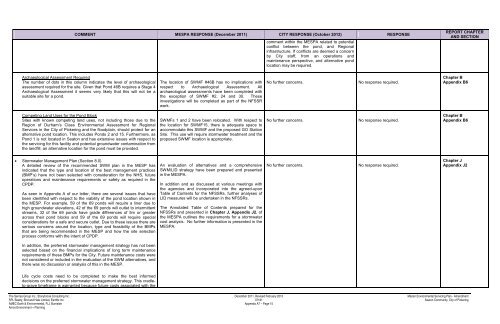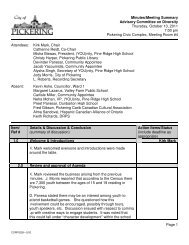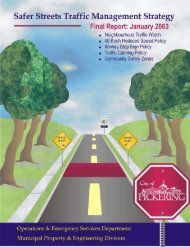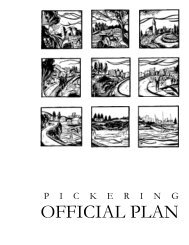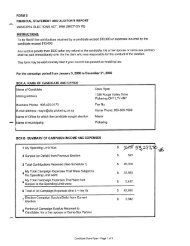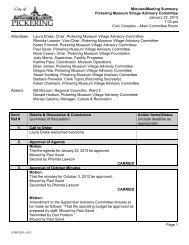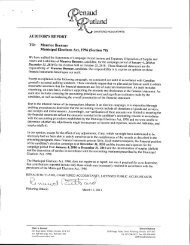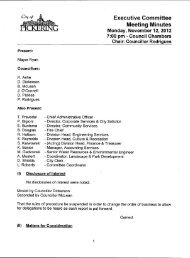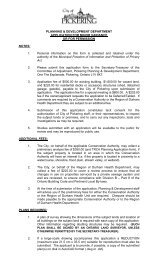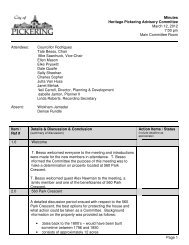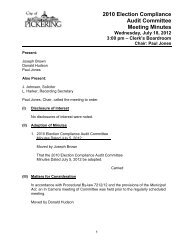Chapter A - Introduction - City of Pickering
Chapter A - Introduction - City of Pickering
Chapter A - Introduction - City of Pickering
Create successful ePaper yourself
Turn your PDF publications into a flip-book with our unique Google optimized e-Paper software.
COMMENT MESPA RESPONSE (December 2011) CITY RESPONSE (October 2012) RESPONSE<br />
comment within the MESPA related to potential<br />
conflict between the pond, and Regional<br />
infrastructure. If conflicts are deemed a concern<br />
by <strong>City</strong> staff, from an operations and<br />
maintenance perspective, and alternative pond<br />
location may be required.<br />
REPORT CHAPTER<br />
AND SECTION<br />
Archaeological Assessment Required<br />
The number <strong>of</strong> dots in this column indicates the level <strong>of</strong> archaeological<br />
assessment required for the site. Given that Pond 46B requires a Stage 4<br />
Archaeological Assessment it seems very likely that this will not be a<br />
suitable site for a pond.<br />
The location <strong>of</strong> SWMF #46B has no implications with<br />
respect to Archaeological Assessment. All<br />
archaeological assessments have been completed with<br />
the exception <strong>of</strong> SWMF #2, 24 and 30. These<br />
investigations will be completed as part <strong>of</strong> the NFSSR<br />
work.<br />
No further concerns.<br />
No response required.<br />
<strong>Chapter</strong> B<br />
Appendix B6<br />
Competing Land Uses for the Pond Block<br />
Sites with known competing land uses, not including those due to the<br />
Region <strong>of</strong> Durham’s Class Environmental Assessment for Regional<br />
Services in the <strong>City</strong> <strong>of</strong> <strong>Pickering</strong> and the floodplain, should protect for an<br />
alternative pond location. This includes Ponds 2 and 15. Furthermore, as<br />
Pond 1 is not located in Seaton and has extensive issues with respect to<br />
the servicing for this facility and potential groundwater contamination from<br />
the landfill, an alternative location for the pond must be provided.<br />
SWMFs 1 and 2 have been relocated. With respect to<br />
the location for SWMF15, there is adequate space to<br />
accommodate this SWMF and the proposed GO Station<br />
Site. This use will require stormwater treatment and the<br />
proposed SWMF location is appropriate.<br />
No further concerns.<br />
No response required.<br />
<strong>Chapter</strong> B<br />
Appendix B6<br />
• Stormwater Management Plan (Section 8.0)<br />
A detailed review <strong>of</strong> the recommended SWM plan in the MESP has<br />
indicated that the type and location <strong>of</strong> the best management practices<br />
(BMP’s) have not been selected with consideration for the NHS, future<br />
operations and maintenance requirements or safety as required in the<br />
CPDP.<br />
As seen in Appendix A <strong>of</strong> our letter, there are several issues that have<br />
been identified with respect to the viability <strong>of</strong> the pond location shown in<br />
the MESP. For example, 59 <strong>of</strong> the 69 ponds will require a liner due to<br />
high groundwater elevations, 42 <strong>of</strong> the 69 ponds will outlet to intermittent<br />
streams, 32 <strong>of</strong> the 69 ponds have grade differences <strong>of</strong> 5m or greater<br />
across their pond blocks and 59 <strong>of</strong> the 69 ponds will require special<br />
considerations for a safe and secure outlet. Due to these issues there are<br />
serious concerns around the location, type and feasibility <strong>of</strong> the BMPs<br />
that are being recommended in the MESP and how the site selection<br />
process conforms with the intent <strong>of</strong> CPDP.<br />
An evaluation <strong>of</strong> alternatives and a comprehensive<br />
SWM/LID strategy have been prepared and presented<br />
in the MESPA.<br />
In addition and as discussed at various meetings with<br />
the agencies and incorporated into the agreed-upon<br />
Table <strong>of</strong> Contents for the NFSSRs, further analyses <strong>of</strong><br />
LID measures will be undertaken in the NFSSRs.<br />
The Annotated Table <strong>of</strong> Contents prepared for the<br />
NFSSRs and presented in <strong>Chapter</strong> J, Appendix J2, <strong>of</strong><br />
the MESPA outlines the requirements for a stormwater<br />
cost analysis. No further information is presented in the<br />
MESPA.<br />
No further concerns.<br />
No response required.<br />
<strong>Chapter</strong> J<br />
Appendix J2<br />
In addition, the preferred stormwater management strategy has not been<br />
selected based on the financial implications <strong>of</strong> long term maintenance<br />
requirements <strong>of</strong> these BMPs for the <strong>City</strong>. Future maintenance costs were<br />
not considered or included in the evaluation <strong>of</strong> the SWM alternatives, and<br />
there was no discussion or analysis <strong>of</strong> this in the MESP.<br />
Life cycle costs need to be completed to make the best informed<br />
decisions on the preferred stormwater management strategy. This cradleto-grave<br />
timeframe is warranted because future costs associated with the<br />
The Sernas Group Inc., Stonybrook Consulting Inc. December 2011, Revised February 2013 Master Environmental Servicing Plan - Amendment<br />
SPL Beatty, Bird and Hale Limited, Earthfx Inc. 07161 Seaton Community, <strong>City</strong> <strong>of</strong> <strong>Pickering</strong><br />
AMEC Earth & Environmental, R.J. Burnside Appendix A7 – Page 15<br />
Amos Environment + Planning


